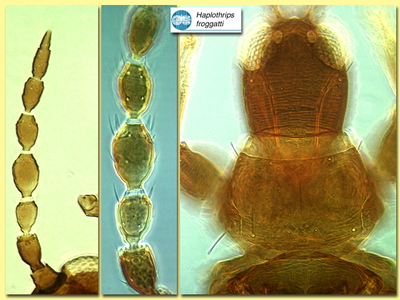Figures
Fig. 1 Antenna, head and pronotum
Fig. 2 Tarsus and tergite X (tube)
Fig. 3 Prosternal plates
Fig. 4 Fore and hind wing
Species
Haplothrips froggatti Hood
Biology
Apparently breeding only in the flowers of Gramineae.
Distribution
Widespread across Australia.
Recognition
Large dark thrips, antennal segment III slightly paler at base; forewing pale with extreme base dark. Antennae 8-segmented; segment III with one sense cone, IV with 4 sense cones; segment III much shorter than IV. Head with maxillary stylets more than one-third of head width apart, with distinct maxillary bridge; postocular setae with apex capitate. Pronotum with 5 pairs of major setae, all with capitate apex. Fore tarsus of female with no tarsal tooth. Forewing constricted medially; distal posterior margin with about 10 duplicated cilia; third sub-basal seta with apex acute. Tergites II-VII each with 2 pairs of sigmoid wing-retaining setae; tergite IX mid-dorsal setae with apex blunt, lateral setae acute.
Related species
The genus Haplothrips includes more than 200 species worldwide, but the very short third antennal segment of this species is most unusual, although it occurs also in one other Australian species (Pitkin, 1973).





